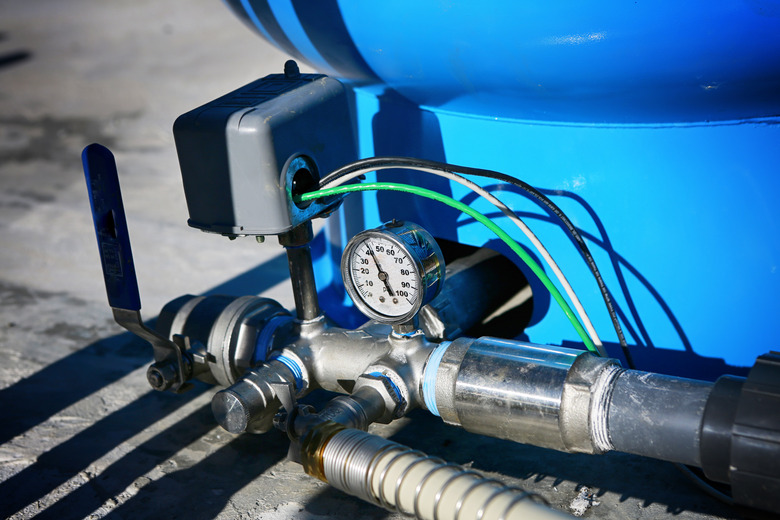Can You Replace The Bladder In A Water Pressure Tank?
We may receive a commission on purchases made from links.
You can replace the bladder in some water pressure tanks but not all of them. Depending on the age of your tank, a replacement bladder may or may not be available. Moreover, the tank itself must have a removable cover. Even if you are able to find a replacement bladder and the tank has a removable cover, most plumbers would recommend replacing your pressure tank rather than replacing the bladder.
If the tank is old enough to have a failed bladder, it's possible it has some internal corrosion that will force replacement after a few years even if the new bladder holds up. A new pressure tank costs $400 to $800, while a new bladder — if you can find one — costs $100 to $300, so the savings could be substantial in the short term depending on the size of the tank. Bladder replacement isn't an easy job, however, because you're usually dealing with a heavy tank full of water, and the money you save might only buy you a few extra years of service.
Diagnosing a Ruptured Pressure Tank Bladder
Diagnosing a Ruptured Pressure Tank Bladder
The bladder in a pressure tank separates air — which is pressurized to around 50 psi — from water, and if the bladder ruptures, the air and water mix. This is known as waterlogging, and when this happens, you'll probably notice one or more of these symptoms:
- The pressure pump will cycle on and off frequently because the tank can't hold pressure, and if this condition persists, the pump will wear out prematurely.
- When you tap on the top of the tank, you'll hear a dull thud rather than the pinging sound you should hear if the bladder was intact and air was collecting near the top as it should.
- When you depress the air valve on the top of the tank, water may spurt out. That shouldn't happen; only air should come out.
- You may notice air spurting out of the faucets in your house.
Dealing With a Heavy Tank
Dealing With a Heavy Tank
The bladder has a direct connection to the water supply, and when it ruptures and water gets into the tank, there's no way for the water to get out. This makes the tank very heavy, and to successfully replace the bladder, you have to move the tank to a place where you can work on it and turn it on its side. A 32-gallon pressure tank is heavy even when empty, but when it's full of water, it weighs more than 250 pounds, so it isn't something you can handle by yourself.
Perhaps three or four burly workers can maneuver the tank and tip it, but in most cases, you're going to need an overhead winch, or you'll need to lift it onto a dolly so you can move it. You'll also need a gang of workers or mechanical help to tip it because the shape of the tank makes it awkward for one person to handle even when it's empty. Simply letting it fall on its own can damage it.
Overview of the Bladder Replacement Procedure
Overview of the Bladder Replacement Procedure
After disconnecting the tank from the plumbing, moving it to a work area, and tipping it on its side, you need to remove the elbow connector and jam nut from the bottom and unscrew the cover, which may be on the top or bottom. You can then pull out the old bladder and the threaded bottom connector, which will be inside it. If the cover is on the top, set the tank upright so you can install the new bladder, but if the cover is on the bottom, leave the tank on its side.
Inspect the replacement bladder for holes. If the cover is on the top, insert the bottom connector into the bladder and then roll up the bladder and insert it into the tank through the top. The connector will fall to the bottom, and you have to retrieve it through the hole in the bottom of the tank. Once you do this, screw on the jam nut and elbow connector (this is easier if you set the tank on its side again) using plumbing tape and/or thread seal to make a watertight connection.
If the cover is on the bottom, you can simply insert the bladder, feed the connector through the cover, replace the cover, and install the jam nut and elbow connector. Charge the tank with air to the pressure recommended by the manufacturer of your pressure pump using a compressor and then connect the tank back to the plumbing and turn on the water.
